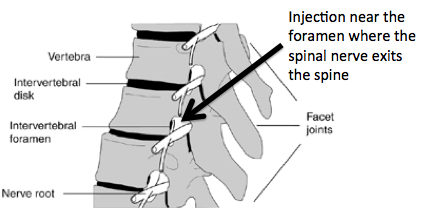 An epidural injection is a treatment option for those with nerve root pain associated with neck or back injury. This procedure may also be referred to as a "selective nerve root block (SNRB) or "epidural nerve block".
An epidural injection is a treatment option for those with nerve root pain associated with neck or back injury. This procedure may also be referred to as a "selective nerve root block (SNRB) or "epidural nerve block".
The nerve root can cause pain if it becomes inflamed or compressed by trauma, herniated disc or other medical condition.
The epidural injection may be performed to 1) determine the specific nerve root that is causing pain and/or 2) provide pain relief. Occasionally, an imaging study (e.g. MRI) may not clearly show which nerve is causing the pain and an epidural nerve block injection is performed to determine if the pain relief is achieved after treating a specific nerve.
The injection inserts lidocaine or other local anesthetic to numb the nerve, and a corticosteroid to reduce inflammation.
The needle is inserted into the spine at the level of the forament where the psinal nerve exits the spine between vertebrae. Flouroscopy (a form of x-ray that allows the physician to view live images of the spine and needle) may used to ensure that the injection is delivered to the correct location.
Pain relief after the injection helps to diagnose the treated nerve as the source of the nerve pain.
Success rates following epidural injection vary depending on the underlying cause of the pain, age of the patient and the presence of other medical conditions.
There is a limit to the number of epidural injections that can be performed during a year due to side effects of the corticosteroid medication used.
Technically, selected nerve root injections are more difficult to perform than epidural steroid injections and should be performed by experienced physicians.
Since the injection is right next to the nerve root, the injection may sometimes lead to a temprorary worsening of pain.
Source: Vivacare
Last updated : 5/13/2022